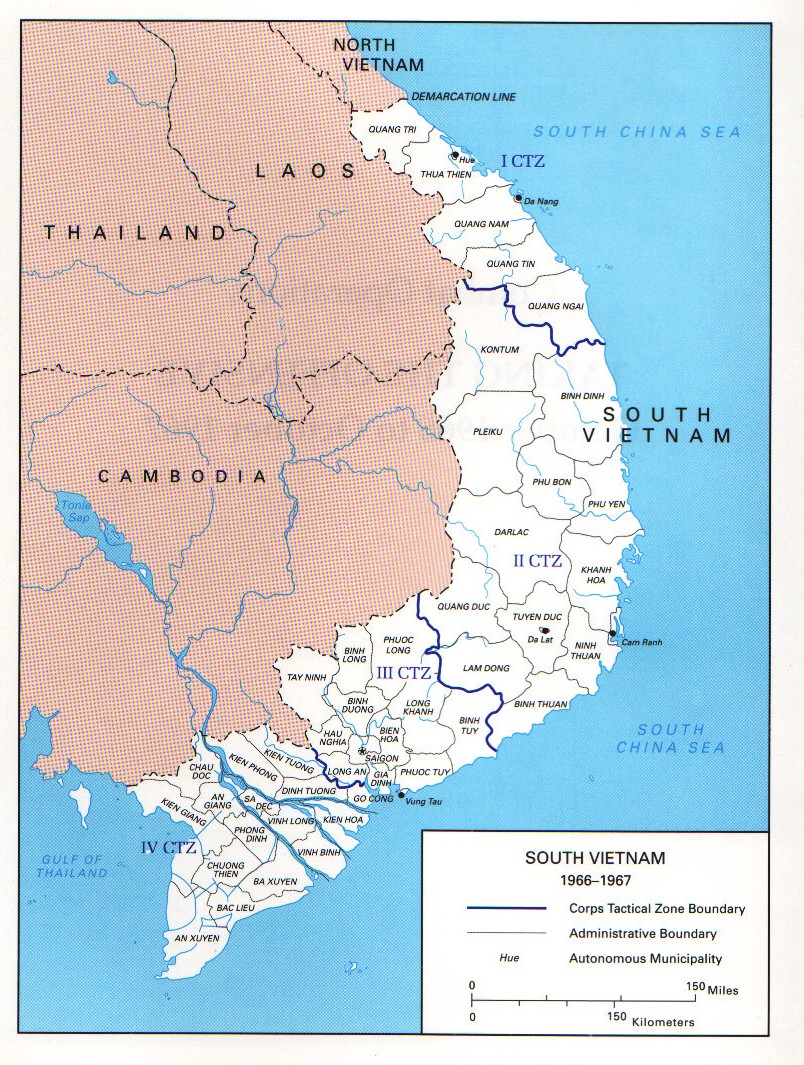Published on 17 Jul 2017
Check out the WW1 Centennial Podcast: http://bit.ly/WW1CCPodcast
Tunnel and mining warfare was an important part of World War 1, especially on the Western Front and to a lesser, but still deadly, degree on the Italian Front. The dangers for the tunnelers were immense. And the destruction they caused with explosions was too.
July 18, 2017
Tunnel Warfare During World War 1 I THE GREAT WAR Special
The upcoming Ken Burns documentary on the Vietnam War
Stephen Sherman discusses some of the things that may or may not be given appropriate treatment in the new PBS documentary series to air this fall, covering American involvement in the former French colonies:

Indochina in 1954. Map prepared for the US Military Acadamy’s military atlas series. (Via Wikimedia).
Ken Burns correctly identifies the Vietnam War as being the point at which our society split into two diametrically opposed camps. He is also correct in identifying a need for us to discuss this aspect of our history in a civil and reflective manner. The problem is that the radical political and cultural divisions of that war have created alternate perceptions of reality, if not alternate universes of discourse. The myths and propaganda of each side make rational discourse based on intellectual honesty and goodwill difficult or impossible. The smoothly impressive visual story Burns will undoubtedly deliver will likely increase that difficulty. He has done many popular works in the past, some of which have been seriously criticized for inaccuracies and significant omissions, but we welcome the chance of a balanced treatment of the full history of that conflict. We can only wait and watch closely when it goes public.
The term “Vietnam War” itself, although accepted in common parlance, would more accurately be called “The American Phase of the Second Indochina War” (1965 to 1973). The U.S. strategic objectives in Vietnam must also be accurately defined. There were two inter-related goals: 1) to counter the Soviet and Red Chinese strategy of fostering and supporting “Wars of National Liberation” (i.e., violent Communist takeovers) in third-world nations, and 2) to defend the government of the Republic of (South) Vietnam from the military aggression directed by its Communist neighbor, the Democratic Republic of (North) Vietnam.
Arguments offered by the so-called “anti-war” movement in the United States were predominantly derived from Communist propaganda. Most of them have been discredited by subsequent information, but they still influence the debate. They include the nonfactual claims that:
1) the war in South Vietnam was an indigenous civil war,
2) the U.S. effort in South Vietnam was a form of neo-colonialism, and
3) the real U.S. objective in South Vietnam was the economic exploitation of the region.
The antiwar movement was not at all monolithic. Supporters covered a wide range, from total pacifist Quakers at one end to passionate supporters of Communism at the other. There were many idealists in it who thought the war was unjust and our conduct of it objectionable, as well as students who were terrified of the draft, and some who just found it the cause of the day. But some of the primary figures leading the movement were not so much opposed to the war as they were in favor of Hanoi succeeding in the war it had started.
The key question is whether the U.S. opposition to Communism during the Cold War (1947 to 1989) was justifiable. The answer is that Communism (Marxism) on a national level is a utopian ideal that can function only with the enforcement of a police state (Leninism) or a genocidal criminal regime (Stalinism). It always requires an external enemy to justify the continuous hardships and repression of its population and always claims that its international duty is to spread Communism. When Ho Chi Minh established the Vietnam Communist Party in 1930, there was no intention of limiting its expansionist ambitions to Vietnam, and he subsequently changed the name to the Indochinese Communist Party at the request of the Comintern in Moscow.
Signs of the libertarian revolution
L. Neil Smith explains how some clearly libertarian trends are being misinterpreted in the latest Libertarian Enterprise:
… primarily as a result of the Internet turning human communications completely sideways, depriving those who have falsely believed they own us of their lofty perches, the 10,000-year-old Age of Authority is ending. Communication between human beings is now lateral, egalitarian, even Tweets from the President, and it doesn’t matter at all how much governments stomp their jackbooted feet or scream and shout. Their kind of social structure is doomed as humanity enters a new era.
One set of consequences of this change is examined, if a bit superficially, in a June article on Breitbart.com by one Liam Deacon, who informs us that a new study finds that “Traditional Views on Same Sex Marriage, Abortion, Pornography [and sex before marriage] in Britain [are] Rapidly Diminishing”. These are trends of the last four years, and to the extent they’ve also occurred long since in America — add in the legalization of marijuana and the increased tendency of individuals to arm themselves against crime and terrorism — it means that most academic and official analyses of socio-political events from, perhaps, the Tea Party Uprising of 2009. through the election of Donald Trump to the triumph of Brexit are dead wrong. We are not undergoing any merely conservative or populist (whatever that means) swing of the pendulum, but an all-out libertarian revolution. I think I know one when I see one: I’ve been doing my best to arrange one for my entire adult life.
According to the study, conducted in 2016, the latest edition of the “British Social Attitudes” survey, resistance from organized Christianity, even the Roman Catholic Church, which used to form a bulwark against social changes like this, is now crumbling, with 64 percent in favor of gay marriage, and 75 percent favoring pre-marital sex. Seventy percent of Catholics believe that abortion is within a woman’s rights. Pornography, too, is now approved by a majority.
Researchers somehow, irrationally, believe that these changes are in opposition to other events, such as “Brexit, Trump, and Le Pen” but they’re wrong. The object in all cases, is self-determination, which is the very heart of libertarianism. Increasingly, people — of all ages, the article observed with a note of amazement — are unwilling to accept dictation from once-respected leaders and traditional social, political, and economic structures. I’d like to believe this is because of the conspicuous failures of authority over the past century or so, but, entirely without condescending — most people are just too busy earning a living and living their lives for theories — I’m not certain that the average person’s thinking is that informed or organized.
More likely, the soap-opera of everyday living has taught them far better than the pompous pronouncements of the fat-heads in power. And for those of us who never believed in Authority, that’s very good news.
The Solow Model and Ideas
Published on 3 May 2016
More Solow Model from MRU’s Macro course: the power of ideas in driving economic growth.
A deeper dive into what helps spur the creation of ideas.
According to our previous videos in this section, the Solow model seems to predict that we’ll always end up in a steady state with no economic growth.
But, the Solow model still has one variable unaccounted for: ideas.
So, can ideas keep us growing?
Ideas do one thing really well: they give us more bang for our buck.
This means we get more output for the same inputs of capital and labor. Ideas are a way of upping our productivity, increasing output per worker across different industries.
Just how much extra output are we talking about?
Well, imagine changing the A variable of the Solow model from 1 to 2. This means a doubling of our productivity.
This shifts the entire output curve upward. When output doubles, so does investment. Once investment comes in faster than depreciation, we end up accumulating capital once again.Thus, the economy keeps growing, which further boosts output.
Now, think of what would happen, if ideas continually improved. With each improvement, ideas would keep shifting the output curve upward, which will continually increase investment as well, and allow us to keep to the left of the steady state.
And when we stay to the left, that means we keep growing.
What all this means is, growth at the cutting edge is determined by two things.
First, it’s determined by how fast new ideas are formed, and second, by how much those ideas increase productivity.
You now have a complete picture of our simple Solow model. It’s a model that accounts for catching up growth, due to capital accumulation, and cutting edge growth, due to the buildup of ideas.
Now, since ideas foster growth at the cutting edge, we’re left with the question that naturally follows: what factors help spur the accumulation of ideas?
That’s what we’ll discuss in the next video, so hang tight!
QotD: Where progressives and libertarians agree
Actually, there are four other big areas where the two ideologies converge.
1. Immigration. Immigration restrictions deprive billions of basic liberties, impoverish the world, and do so on the backs of the global poor, most of whom are non-white.
2. Occupational licensing. Licensing laws bar tens of millions of people from switching to more lucrative and socially valuable occupations, all to benefit richer insiders at the expense of poorer outsiders.
3. War, especially the War on Terror. Since 2002, the U.S. has literally spent trillions fighting the quantitatively tiny problem of terrorism by waging non-stop wars in the Middle East. We don’t know what the Middle East would have looked like if the U.S. had stayed out, but it’s hard to believe it would be worse. And there’s no end in sight.
4. The criminal justice system, especially the War on Drugs. Hundreds of thousands of non-violent people, disproportionately poor and non-white, are in prison. Why? To stop willing consumers from doing what they want with their own bodies.
These four issues are so massive, you’d expect a staunch progressive/libertarian alliance would have been forged long ago. But of course it hasn’t. Why not? Some progressives flatly disagree with one or more of these policies; see Bernie contra open borders. But the bigger stumbling block is that progressives place far lower priority on these issues than libertarians. That includes war, unless the Republicans hold the White House.
Why not? I regretfully invoke my Simplistic Theory of Left and Right. The heart of the left isn’t helping the poor, or reducing inequality, or even minority rights. The heart of the left is being anti-market. With some honorable exceptions, very few leftists are capable of being excited about deregulation of any kind. And even the leftists who do get excited about well-targeted deregulation get far more excited about stamping out the hydra-headed evils of market.
Bryan Caplan, “Progressive/Libertarian: The Alliance That Isn’t”, Library of Economics and Liberty, 2017-06-22.




